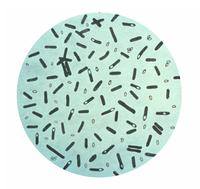
Photo from wikipedia
OBJECTIVE To analyze the epidemiologic data of patients with Clostridium botulinum food poisoning, and to improve the understanding, diagnosis and treatment of food borne botulism. METHODS A retrospective study was… Click to show full abstract
OBJECTIVE To analyze the epidemiologic data of patients with Clostridium botulinum food poisoning, and to improve the understanding, diagnosis and treatment of food borne botulism. METHODS A retrospective study was conducted. Fifty-three patients with Clostridium botulinum food poisoning admitted to Chinese PLA Center of Poisoning and Treatment from January 2009 to December 2016 were enrolled, and they were divided into mild, moderate, and severe groups according to the severity of disease. The clinical data including medical history, epidemiology data, routine blood test and blood biochemistry at hospital admission, the vital signs and arterial blood gas analysis before and after treatment, as well as the occurrence frequency of symptom and sign on set were collected. RESULTS Fifty-three patients with food borne botulism were enrolled, with 33 patients in mild group, 13 in moderate group, and 7 in severe group. Most of the patients were female, the age distribution was in large span, the outbreak of disease was in groups mainly with the family, and patients were mainly located in Hebei Province, Beijing and Henan Province. The outbreaks were mainly happened in Spring and Summer, and homemade fermentation products were still the first cause of poisoning with the average latent period of (51.01±4.78) hours. The majority of patients with botulism were in mild resulted from the type A toxin. With the aggravation of disease, hospitalization time was gradually increased, white blood cell (WBC) and neutrophils (NEUT) at hospitalization admission, and respiratory rate (RR), heart rate (HR), fraction of inspired oxygen (FiO2) before the treatment were shown in obviously rising trend, albumin (ALB) at hospitalization admission and pH, arterial partial pressure of oxygen (PaO2), arterial oxygen saturation (SaO2) before treatment were in decline. The parameters in severe group were most severe, and had significant differences as compared with those of mild group [hospitalization time (days): 72.57±39.52 vs. 6.61±3.72, WBC (×109/L): 13.01±6.44 vs. 6.85±2.07, NEUT: 0.85±0.07 vs. 0.63±0.14, RR (bpm): 32.14±4.33 vs. 15.18±1.70, HR (bpm): 132.29±5.19 vs. 75.54±8.24, FiO2: 0.32±0.05 vs. 0.21±0.00, ALB (g/L): 38.57±4.65 vs. 42.09±4.57, pH: 7.08±0.10 vs. 7.38±0.07, PaO2 (mmHg, 1 mmHg = 0.133 kPa): 75.16±5.24 vs. 98.39±1.50, SaO2: 0.78±0.06 vs. 0.97±0.02, all P < 0.05]. The symptom and sign on set of 53 patients with food borne botulism was dizziness, followed by fatigue, blurred vision, nausea, and other symptoms and signs were lower than 50%, and the occurrence of dizziness with rank one happen rate was significantly higher than blurred vision and nausea (χ 2 values were 7.209 and 10.502 respectively, and P values were 0.007 and 0.004 respectively). After the on time prescription of botulinum antitoxins treatment, the clinical symptoms of patients could be relived quickly. All the patients were discharged without deaths. CONCLUSIONS In order to improve the recovery of the food borne botulism poisoning patients, adequate antitoxin and the related organ supports should be prescribed on time.
Journal Title: Zhonghua wei zhong bing ji jiu yi xue
Year Published: 2017
Link to full text (if available)
Share on Social Media: Sign Up to like & get
recommendations!